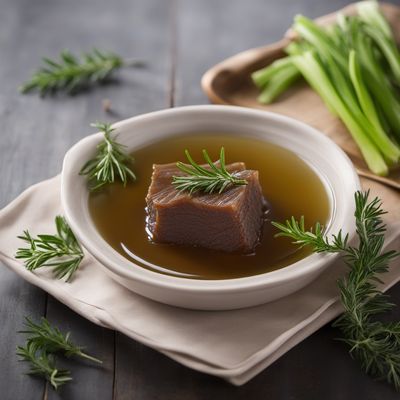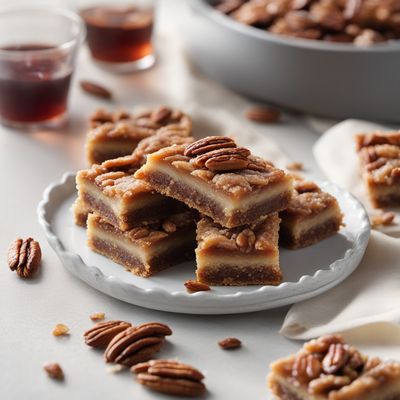
Recipe
Jellied Moose Nose with a Haute Cuisine Twist
Elevating Canadian Delicacy: Jellied Moose Nose with a Haute Cuisine Twist
3.8 out of 5
Indulge in the refined flavors of haute cuisine with this elevated version of the traditional Canadian dish, Jellied Moose Nose. This recipe combines the unique texture and taste of jellied moose nose with the sophistication and elegance of haute cuisine techniques.
Metadata
Preparation time
30 minutes
Cooking time
4-5 hours
Total time
6 hours 30 minutes
Yields
4 servings
Preparation difficulty
Medium
Suitable for
High protein, Low carb, Paleo, Keto, Gluten-free
Allergens
Gelatin
Not suitable for
Vegetarian, Vegan, Dairy-free, Nut-free, Egg-free
Ingredients
In this haute cuisine adaptation, we elevate the traditional jellied moose nose by incorporating refined techniques and flavors. The moose nose is slow-cooked to perfection, ensuring a tender and gelatinous texture. The aspic jelly is delicately flavored with aromatic herbs and spices, adding a sophisticated touch to the dish. Additionally, the presentation is enhanced with elegant plating techniques, making this version of jellied moose nose a true haute cuisine masterpiece. We alse have the original recipe for Jellied Moose Nose, so you can check it out.
-
1 moose nose (approximately 2 kg / 4.4 lbs) 1 moose nose (approximately 2 kg / 4.4 lbs)
-
2 onions, chopped 2 onions, chopped
-
4 carrots, chopped 4 carrots, chopped
-
4 celery stalks, chopped 4 celery stalks, chopped
-
4 garlic cloves, minced 4 garlic cloves, minced
-
2 bay leaves 2 bay leaves
-
10 black peppercorns 10 black peppercorns
-
4 sprigs of thyme 4 sprigs of thyme
-
4 sprigs of parsley 4 sprigs of parsley
-
4 cups (946 ml) beef stock 4 cups (946 ml) beef stock
-
1 cup (237 ml) dry white wine 1 cup (237 ml) dry white wine
-
4 gelatin sheets 4 gelatin sheets
-
Salt and pepper to taste Salt and pepper to taste
Nutrition
- Calories (kcal / KJ): 350 kcal / 1465 KJ
- Fat (total, saturated): 12g, 4g
- Carbohydrates (total, sugars): 10g, 4g
- Protein: 50g
- Fiber: 2g
- Salt: 1g
Preparation
-
1.Place the moose nose in a large pot and cover it with water. Bring to a boil and let it simmer for 10 minutes. Drain and rinse the moose nose.
-
2.In the same pot, heat some oil and sauté the onions, carrots, celery, and garlic until they are softened.
-
3.Add the moose nose back to the pot along with bay leaves, black peppercorns, thyme, parsley, beef stock, and white wine. Season with salt and pepper.
-
4.Bring the mixture to a boil, then reduce the heat and let it simmer for 4-5 hours, or until the moose nose is tender and easily pierced with a fork.
-
5.Remove the moose nose from the pot and let it cool slightly. Strain the cooking liquid and set it aside.
-
6.Once the moose nose is cool enough to handle, remove any excess fat and cartilage. Slice the moose nose into thin, bite-sized pieces.
-
7.Soften the gelatin sheets in cold water for a few minutes, then squeeze out any excess water. Dissolve the gelatin sheets in the reserved cooking liquid.
-
8.Arrange the sliced moose nose in a mold and pour the gelatin mixture over it, ensuring that the moose nose is fully covered.
-
9.Refrigerate the mold for at least 6 hours, or until the gelatin is set.
-
10.To serve, carefully unmold the jellied moose nose onto a platter and garnish with fresh herbs. Slice and enjoy!
Treat your ingredients with care...
- Moose nose — Ensure that the moose nose is thoroughly cleaned and trimmed of any excess fat and cartilage before cooking.
- Gelatin sheets — Follow the instructions on the packaging to soften and dissolve the gelatin sheets properly.
Tips & Tricks
- For an extra touch of elegance, garnish the jellied moose nose with edible flowers or microgreens.
- Serve the dish with a side of crusty bread or toast points to add some texture and variety to each bite.
- If you prefer a stronger flavor, you can add a splash of brandy or cognac to the gelatin mixture before pouring it over the moose nose.
- Experiment with different herbs and spices in the aspic jelly to customize the flavor profile to your liking.
- Leftover jellied moose nose can be stored in the refrigerator for up to 3 days.
Serving advice
Serve the jellied moose nose chilled, allowing the flavors to fully develop. Accompany it with a light salad or pickled vegetables to provide a refreshing contrast to the richness of the dish.
Presentation advice
To create an elegant presentation, carefully unmold the jellied moose nose onto a platter and garnish it with fresh herbs. Consider using a decorative mold to add a touch of sophistication to the dish.
More recipes...
For Jellied Moose Nose
For Canadian cuisine » Browse all
More Canadian cuisine dishes » Browse all

Tarte à la bouillie
Pudding tart
Tarte à la bouillie is a traditional French dessert made with a shortcrust pastry base and a creamy custard filling.

Maple Bar Doughnut
The Maple Bar Doughnut is a classic American pastry that is loved by many. It is a yeast-raised doughnut that is fried until golden brown and then...

Jellied Moose Nose
Jellied Moose Nose is a traditional Canadian dish made with moose nose.








